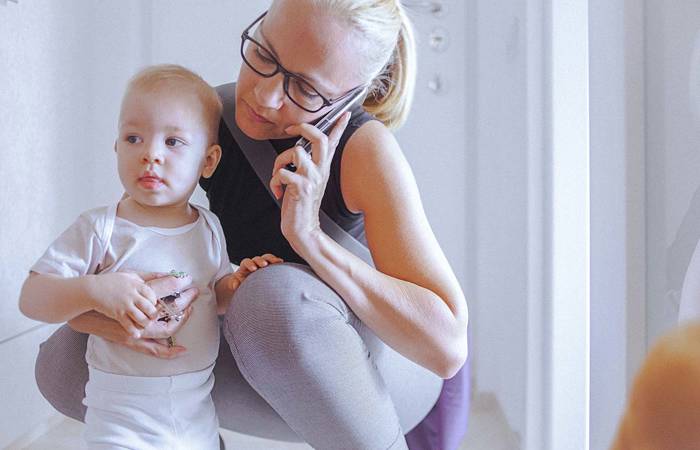Like what you see?
Sign up to receive more free parenting advice.
Thank you for subscribing to our newsletter!
Lifestyle

Dad_iStock-955426438_1500x900
As the needs of modern families change, so too is the use of parental leave by Aussie dads.
Fathers’ uptake of parental leave has doubled in the last 12 months, according to the first Workplace Gender Equality Agency’s (WEGA) Gender Equality Scorecard.
“Even though it’s still low at 12 per cent, the year before it was only 6 per cent, so it’s been an encouraging increase,” explains Dr Janin Bredehoeft, Research and Analytics Executive Manager at the WGEA.
She attributes the change to removing the stereotypes and stigma around gendered parental leave.
Traditionally, parental leave is separated into two categories: primary and secondary.
“Primary and secondary parental leave is associated with the length of leave stereotypically ‘needed’ by each parent, with primary leave anywhere between 7 to 26 weeks, while secondary leave is usually two weeks,” explains Dr Bredehoeft.
“This division reinforces traditional stereotypes where primary leave is linked to the mother who is ‘needed’ by the baby to stay home for a longer period.
“While secondary leave is linked to the father whose main role is to return to work, as soon as possible, due to the perception that he needs to be the breadwinner for the family.
“These are such outdated concepts. Both parents are parents. Both parents have equal responsibilities. Both parents need to stay at home to care for the child.”
The Scorecard found that three in five employers now offer gender neutral employer-funded paid parental leave. In other words, one parental leave offered to all parents.
“Gender neutral parental leave acknowledges that we are all parents and all care for the child,” says Dr Bredehoeft.
“The removal of labels is very powerful to shift stereotypes.”
Organisations who led the gender neutral parental leave trend, as early as 2019, are seeing an increase in fathers utilising parental leave – with fathers accounting for more than half of employees in these organisations taking parental leave.
Another encouraging finding from the Scorecard is management are showing the way.
“Senior managers are among the majority of fathers who took parental leave,” adds Dr Bredehoeft.
“This is really encouraging as it shows great role modelling.”
In another right step for families, particularly women who are still the majority of employees who take paid parental leave, four out of five organisations are now paying superannuation on parental leave.
Unfortunately, male dominated industries are less likely to offer gender neutral parental leave compared to female dominated industries.
“While it is great to see employers changing their policies, we need to acknowledge that it isn’t just one or two things that need to change, best practice recommendations call for a combination of measures,” reinforces Dr Bredehoeft.
“These include the removal of primary and secondary labels, providing over 26 weeks of paid parental leave, removing the eligibility period for parental leave, paying superannuation on parental leave and supporting employees return to work through a number of measures such as flexibility in working arrangements or removing financial key performance indictors to reduce stress and anxiety for new parents.”
Gender neutral parental leave acknowledges that we are all parents and all care for the child.Dr Janin Bredehoeft
Stay up to date with the latest news and articles from First Five Years
Thank you for subscribing to our newsletter!
The benefits for taking leave
Fathers taking parental leave isn’t just about having a second set of hands to change nappies, the benefits radiate beyond the family unit.
“Fathers taking parental leave is the key to challenging norms and breaking stereotypes as it sets up the family right from the start,” says Dr Bredehoeft.
“We know from research that fathers who take leave are more engaged in family life, they don’t buy into the stereotype that a child needs their mother more than their father, or that men should be strong.
“Having access to parental leave has a lot of health and wellbeing benefits for the family.”
A 2014 Swiss study found that gender neutral parental leave enabled a more equal division of work – both employed paid work and unpaid work in the home – between women and men by fostering parental involvement in the care of the child.
A study conducted by McKinsey in 2021 found that 90 per cent of surveyed fathers who took paid parental leave noticed an improvement in their relationship with their partners.
Fathers weren’t only able to establish a special bond with their child, but they reported parenting together was instrumental in shaping family dynamics and setting up a foundation for a more equal distribution of childcare responsibilities, not only at the start, but in future years.
Fathers also said their leave helped support their partner’s career goals and minimised any negative impact on their partner’s career progression.
“For us as a society, when men take parental leave the benefits extend beyond the family unit,” adds Dr Bredehoeft.
“Women are more likely to return to work, which increases the female workforce and participation which is beneficial for the economy.”
The McKinsey study also found fathers who took parental leave reported an increase in total household financial wellbeing in the long term.
A 2016 Ernst Young study found that employers who offered paid parental leave had employees who displayed higher morale and were more productive.
“There are also studies show that having fathers at home reduces infant mortality rates, increases breast feeding rates and improves health outcomes for mothers and children,” adds Dr Bredehoeft.
Why aren’t more fathers taking parental leave?
With the numerous benefits and the increasing availability of gender-neutral leave, there is only one question: why aren’t more men taking up parental leave?
“It’s related to the stereotypes and the norms of society,” explains Dr Bredehoeft.
“In some cases, there are organisations who offer gender neutral paid parental leave, but no men have used it, so it’s daunting being the first and breaking that established culture.
“In addition, they may fear they are more likely to miss out on a promotion or career opportunity, which we see happen to women who take parental leave.
“We really need role models who take parental leave and shift the culture.”
So, how to be the first?
Dr Bredehoeft recommends employees put forward a business case to their employers on the documented benefits of taking parental leave.
“Paid parental leave is evidenced as one of the key mechanisms for the retention and attraction of staff,” she says.
“Employees can highlight that it is an investment, not a cost, to the business.”
She adds that it’s also an opportunity for the development and training of other employees in the organisation who can take up greater responsibility while the employee is on parental leave.
“Employees also need to remember that organisations who offer parental leave are supporting their staff to go on parental leave and therefore, shouldn’t hesitate to use that employee benefit.”
WGEA has a comprehensive dataset which details the policies of organisations with 100 plus employees, including their parental leave policy, so employers can benchmark themselves and employees can search for organisations with policies best suited to their needs.







